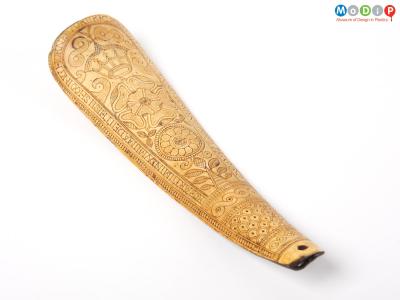Horn has made both a practical and an ornamental contribution to fashion.
The hollow part of some horns is ideally fitted to the function of a shoe-horn (1 - 2). The decorated example (3) dates from 1612 and is lettered with the name of its engraver. Sometimes shoe-horns had more than one function as in the example at (4) which in addition to having a carved hand at one end to use as a back scratcher has a sword hidden within it. The example at (5) doubles as a shoe horn and a button hook (6). Horn of various kinds was often used to provide the handles for boot pulls but in the example at (7) the pull itself is made from a tip of goat or antelope horn. Fingers used to be eased into tight-fitting leather gloves with the help of French chalk kept in small flasks turned on a lathe (8 - 11).
The back combs, fans and necklaces are examples of horn used to craft fashion accessories. The 17th century back combs (12 - 13) are made from plates of translucent ox horn with elaborately pierced designs created by a mixture of cutting with a thin wire held in a tiny saw and pressing by hand. The teeth of the 19th back comb (14) however will have been cut by machine and hand-finished. Fans were very popular early in the 19th century. The example at (15) is made from overlapping sticks of translucent horn also wire-cut by hand and it has been stained to resemble tortoiseshell, a more expensive material. Its piercing is unusually delicate. The turned bead necklaces (16 - 17) demonstrate the subtlety and variety of colour of which horn is capable.

















